From Utility to
Beauty
by Bob Brooke
 Pottery,
that is earthenware and stoneware, had been delegated to everyday
utility use for centuries, In the 18th century, earthenware was the
only pottery made in the American Colonies. Those people who wanted
elegant porcelain dinnerware and decorative pieces had to import
them at great expense, mostly from England, but also from France and
The Netherlands. Pottery,
that is earthenware and stoneware, had been delegated to everyday
utility use for centuries, In the 18th century, earthenware was the
only pottery made in the American Colonies. Those people who wanted
elegant porcelain dinnerware and decorative pieces had to import
them at great expense, mostly from England, but also from France and
The Netherlands.
By the early 19th century, American potteries began producing
porcelains of their own. And by the 1850s, earthenware and stoneware
had disappeared into the kitchens of the wealthy to once again be
used only for utilitarian purposes. The Industrial Revolution
provided the technology for ceramics to be mass produced, thus
taking them out of the realm of the individual potter.
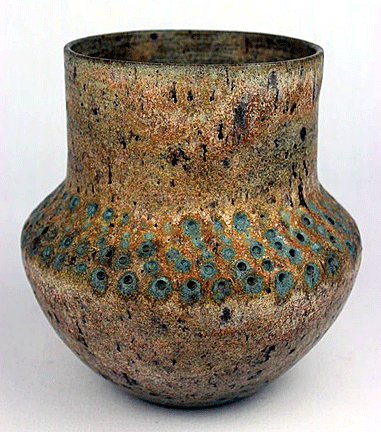 The
English Arts and Crafts Movement, begun by William Morris, focused
once again on handcrafted pottery. But this time, potters began
producing earthenware and stoneware that was not only useful but
beautifully crafted. The
English Arts and Crafts Movement, begun by William Morris, focused
once again on handcrafted pottery. But this time, potters began
producing earthenware and stoneware that was not only useful but
beautifully crafted.
The handcraft concept made its way over the Atlantic Ocean to the
United States, where potters eagerly set to work crafting their own
earthenware pottery designs.
The Arts and Crafts pottery movement began in America in the 1870s.
Historians generally agree that the original Arts and Crafts
Movement ended around 1920. It resulted in a return to the
creativity and simplicity associated with the craft of producing
hand-made art pottery. It also reflected an abandonment of
mass-produced art pottery in favor of the uniqueness and simplicity
of style, form and glaze typically seen in Arts and Crafts pottery.
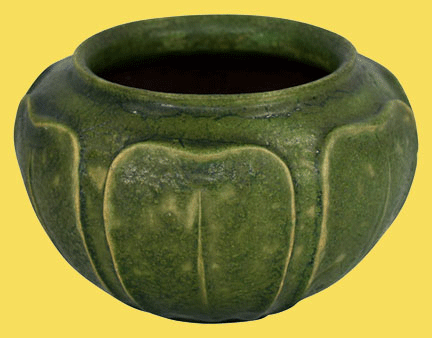 The
Arts and Crafts movement is typically defined by the pottery
produced by companies such as Grueby, Marblehead, Newcomb College,
Wheatley, Teco, Rookwood, and early Van Briggle pottery. The Arts
and Crafts style pottery movement relied upon the integrated
expression of form and design by an individual craftsman who would
typically individually complete the production of a piece of Arts
and Crafts pottery. Today, many small studio potters are returning
to the roots of the original Arts and Crafts movement The
Arts and Crafts movement is typically defined by the pottery
produced by companies such as Grueby, Marblehead, Newcomb College,
Wheatley, Teco, Rookwood, and early Van Briggle pottery. The Arts
and Crafts style pottery movement relied upon the integrated
expression of form and design by an individual craftsman who would
typically individually complete the production of a piece of Arts
and Crafts pottery. Today, many small studio potters are returning
to the roots of the original Arts and Crafts movement
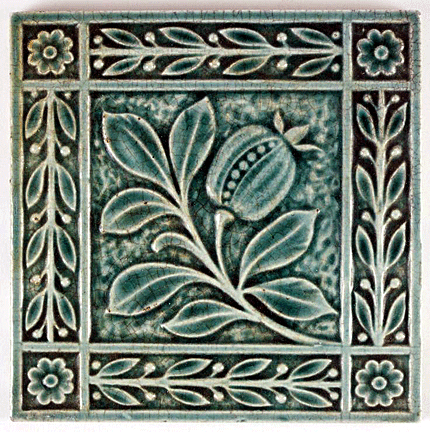 American
art pottery refers to aesthetically distinctive hand-made ceramics
in earthenware and stoneware from the period 1870 to the 1950s.
Ranging from tall vases to tiles, the work features original
designs, simplified shapes, and experimental glazes and painting
techniques. American
art pottery refers to aesthetically distinctive hand-made ceramics
in earthenware and stoneware from the period 1870 to the 1950s.
Ranging from tall vases to tiles, the work features original
designs, simplified shapes, and experimental glazes and painting
techniques.
Art pottery was made by some 200 studios and small factories across
the country, with especially strong centers of production in Ohio at
the Cowan, Lonhuda, Owens, Roseville, Rookwood, and Weller Potteries
and in Massachusetts at the Dedham, Grueby, Marblehead, and Paul
Revere Potteries. Competition from commercial mass-production
companies, as well as the advent of World War I followed a decade
later by the Great Depression forced most of them out of business.
The American art pottery movement developed out of the tradition of
individual potters making utilitarian earthenware and stoneware
vessels for everyday use that dates back to Colonial America.
Differing locations, the potters' appreciation for Native American
pottery traditions, and modernist aesthetics helped to influence its
evolution. Frederick Hurten Rhead, who worked with several different
art potteries, and Maria Longworth Nichols, whose Rookwood Pottery
produced what many consider some of the very best American art
pottery, were two of its most influential artists.
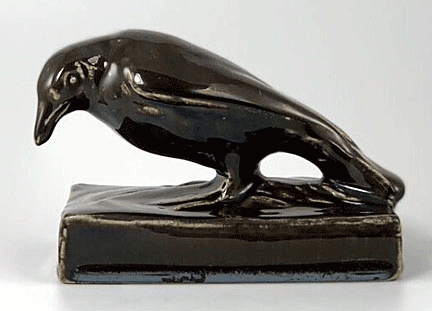 Later
art pottery designs became more graphic, linear, and abstract. But
flowers and animals, like Rookwood's eponymous rook remained popular
subjects for decorations throughout the Movement. Some pieces had
three-dimensional features, such as designs incised into the surface
rather than painted on top, or raised elements like slip-trailed
patterns or low-relief sculptures. Later
art pottery designs became more graphic, linear, and abstract. But
flowers and animals, like Rookwood's eponymous rook remained popular
subjects for decorations throughout the Movement. Some pieces had
three-dimensional features, such as designs incised into the surface
rather than painted on top, or raised elements like slip-trailed
patterns or low-relief sculptures.
While many of the key figures in the movement founded or were
affiliated with specific potteries, a few remained essentially
independent throughout their careers. Notable in this group are John
Bennett, who worked in New York and New Jersey, and Adelaïde Alsop
Robineau, whose Scarab Vase is considered one of the finest examples
of American art pottery. Also operating "independently" was the vast
factory of Edwin Bennett in Baltimore which periodically produced
fine examples of art pottery, although the overall focus of the
business was industrial.
Rookwood Pottery Company
Maria Longworth Nichols Storer, who was influenced by Japanese and
French ceramics, founded the Rookwood Pottery in Cincinnati, Ohio,
in 1880. Rookwood became known for experimenting with glazes and for
the exceptionally high quality of its painted and incised work. The
Pottery’s production standards and quality control were second to
none. Often what was considered average quality for Rookwood Pottery
would have been considered exceptional for Roseville, Weller and
other makers. The primary Arts and Crafts lines produced by Rookwood
were its hand carved and painted matte lines.

Roseville Pottery
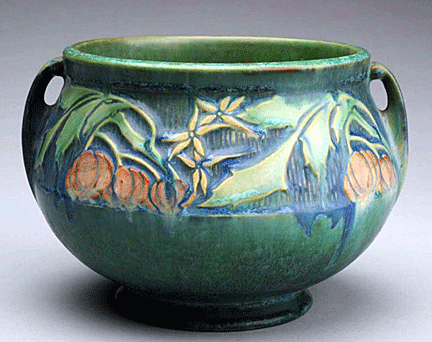 The
Roseville Pottery began in Roseville, Ohio, in 1890 then moved to
Zanesville eight years later. It began by making housewares and only
began making art pottery around 1900. More collectors collect Roseville
pottery than any other American art pottery maker. The most recognized
hand crafted, Arts and Crafts Roseville pottery includes Della Robbia
introduced by Frederick Rhead and Fujiyama created by Gazo Fujiyama.
Frank Ferrell is another recognized Roseville designer. The
Roseville Pottery began in Roseville, Ohio, in 1890 then moved to
Zanesville eight years later. It began by making housewares and only
began making art pottery around 1900. More collectors collect Roseville
pottery than any other American art pottery maker. The most recognized
hand crafted, Arts and Crafts Roseville pottery includes Della Robbia
introduced by Frederick Rhead and Fujiyama created by Gazo Fujiyama.
Frank Ferrell is another recognized Roseville designer.
Teco Pottery
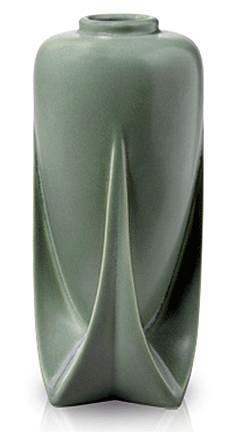 William
Day Gates founded the Teco Pottery in Terra Cotta, Illinois, in 1899 as
a specialty branch of his American Terra Cotta Tile and Ceramic Company
which made architectural terra cotta items like drain tiles and chimney
tops. Gates's experiments with glazes and forms led him to found Teco—an
acronym for TErra COtta—to create art pottery, especially vases. Teco
became known for its distinctive architecturally styled wares with
little to no surface decoration and for a medium-green matte glaze. Most
designs were the work of Gates himself, but a few Chicago-based Prairie
School architects also made works for Teco. The firm’s matte green
pottery set the standard for the Prairie School branch of the Arts and
Crafts Movement. Teco’s geometric and architectural vases complemented
Frank Lloyd Wright and Prairie- or Mission- style homes. The potters at
Teco primarily molded rather than handcrafted its pottery. William
Day Gates founded the Teco Pottery in Terra Cotta, Illinois, in 1899 as
a specialty branch of his American Terra Cotta Tile and Ceramic Company
which made architectural terra cotta items like drain tiles and chimney
tops. Gates's experiments with glazes and forms led him to found Teco—an
acronym for TErra COtta—to create art pottery, especially vases. Teco
became known for its distinctive architecturally styled wares with
little to no surface decoration and for a medium-green matte glaze. Most
designs were the work of Gates himself, but a few Chicago-based Prairie
School architects also made works for Teco. The firm’s matte green
pottery set the standard for the Prairie School branch of the Arts and
Crafts Movement. Teco’s geometric and architectural vases complemented
Frank Lloyd Wright and Prairie- or Mission- style homes. The potters at
Teco primarily molded rather than handcrafted its pottery.
Weller Pottery
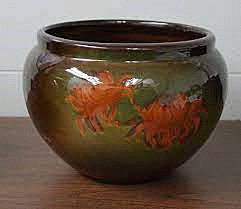 Potter
Samuel A. Weller founded the Weller Pottery in Fultonham, Ohio, in 1872.
The company turned out both art pottery and mass-produced work, becoming
the largest pottery in the country by 1905. Many different potters
worked at Weller over the years, including Frederick Rhead, who was
there in 1903–04. For this reason, it has less of a signature style than
some of the smaller art potteries. The early, hand-decorated pottery
vases produced by Weller compare very favorably with that produced by
Roseville. While Frederick Rhead was the leader at Roseville, Weller
Pottery was blessed with the services of Jacques Sicard who developed
the Sicard line. Potter
Samuel A. Weller founded the Weller Pottery in Fultonham, Ohio, in 1872.
The company turned out both art pottery and mass-produced work, becoming
the largest pottery in the country by 1905. Many different potters
worked at Weller over the years, including Frederick Rhead, who was
there in 1903–04. For this reason, it has less of a signature style than
some of the smaller art potteries. The early, hand-decorated pottery
vases produced by Weller compare very favorably with that produced by
Roseville. While Frederick Rhead was the leader at Roseville, Weller
Pottery was blessed with the services of Jacques Sicard who developed
the Sicard line.
<
Back to Caring for Your Collections
Archives
Next Article
>
|
